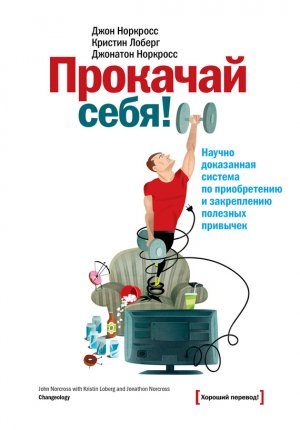Прокачай себя! Научно доказанная система по приобретению и закреплению полезных привычек Норкросс Джон

Beck, A. T., Rush, A. J., Shaw, B. E., & Emery, G. (1979). Cognitive therapy of depression. New York: Guilford.
Begley, S. (2010, June 14). My alleles made me do it: the folly of blaming bad behavior on wonky DNA. www.thedailybeast.com/newsweek/blogs/the-human-condition/2010/06/13/my-aileles-made-me-do-it-bad-behavior-blamed-on-wonky-dna.html.
Benjamin, A. (1987). The helping interview. Boston: Houghton Mifflin.
Bike, D. H., Norcross, J. C., & Schatz, D. M. (2009). Processes and outcomes of psychotherapists’ personal therapy: replication and extension 20 years later. Psychotherapy, 46, 19–31.
Boice, R. (2000). Advice for new faculty members. Boston: Allyn & Bacon.
Borland, R. (1990). Slip-ups and relapse in attempts to quit smoking. Addictive Behaviors, 15, 235–245.
Brogan, M. M., Prochaska, J. O., & Prochaska, J. M. (1999). Predicting termination and continuation status in psychotherapy using the transtheoretical model. Psychotherapy, 36, 105–113.
Brownell, K. D., Marlatt, G. A., Lichtenstein, E., & Wilson, G. T. (1986). Understanding and preventing relapse. American Psychologist, 41, 765–782.
Burns, D. (1999). Feeling good: the new mood therapy. New York: Avon.
Carroll, K. M. (1996). Relapse prevention as a psychosocial treatment: a review of controlled clinical trials. Experimental and Clinical Psychopharmacology, 4, 765–782.
Chouinard, M. C., & Robichaud-Ekstrand, S. (2007). Predictive value of the transtheoretical model to smoking cessation in hospitalized patients with cardiovascular disease. European Journal of Cardiovascular Prevention and Rehabilitation, 14 (1), 51–58.
Cialdini, R. B. (2008). Influence: science and practice (5th ed.). New York: Prentice Hall.
Coelho, P. (1993). The alchemist. New York: HarperCollins.
Colino, S. (2001, January). The decision that changed my life. Ladies’ Home Journal, 84–86.
Corrigan, P. (2004). How stigma interferes with mental health care. American Psychologist, 59, 614–625.
Cuijpers, P. (1997). Bibliotherapy in unipolar depression: a meta-analysis. Journal of Behavior Therapy and Experimental Psychiatry, 28, 139–147.
Curry, S. G., & Marlatt, G. A. (1985). Unaided quitters’ strategies for coping with temptations to smoke. In S. Shiftman & T. A. Wills (Eds.) Coping and substance use (pp. 243–265). New York: Academic Press.
DiClemente, C. C. (2003). Addiction and change: how addictions develop and addicted people recover. New York: Guilford.
DiClemente, C. C., Prochaska, J. O., Fairhurst, S. K., et al. (1991). The process of smoking cessation: an analysis of precontemplation, contemplation and preparation stages of change. Journal of Consulting and Clinical Psychology, 59, 295–304.
Eisenberg, D. M., Davis, R. B., Ettner, S. L., et al. (1998). Trends in alternative medicine use in the United States, 1990–1997. Journal of the American Medical Association, 280, 1589–1575.
Epcot Poll. (1985). Resolutions not kept long by most Americans. Lake Buena Vista, Fla.: Walt Disney World.
Geller, J. D., Norcross, J. C., & Orlinsky, D. E. (Eds.) (2005). The psychotherapist’s own psychotherapy: patient and clinician perspectives. New York: Oxford University Press.
Gibbs, N. (2004, July 5). Made your July 1 resolutions? Time, 98–99.
Gollwitzer, P. M. (1999). Implementation intentions: strong effects of simple plans. American Psychologist, 54, 493–503.
Goodwin, D. K. (2006). Team of rivals: the political genius of Abraham Lincoln. New York: Simon & Schuster.
Greenwald, J. (1998, November). Herbal healing. Time, 61–68.
Gritz, E. R., Carr, C. R., & Marcus, A. C. (1988). Unaided smoking cessation: Great American Smokeout and New Year’s Day quitters. Journal of Psycho-social Oncology, 6, 217–234.
Hall, K. L., & Rossi, J. S. (2008). Meta-analytic examination of the strong and weak principles across 48 health behaviors. Preventive Medicine, 46 (3), 266–274.
Hatzigeorgiadis, A., Zourbanos, N., Galanis, E., & Theodorakis, Y. (2011). Self-talk and sports performance: a meta-analysis. Perspectives on Psychological Science, 6 (4), 348–356.
Isenhart, C. E. (1997). Pretreatment readiness for change in male alcohol dependent subjects: predictors of one-year follow-up status. Journal of Studies on Alcohol, 58 (4), 351–357.
James, W. (1890). Principles of Psychology. http://psychclassics.yorku.ca/James/Principles/index.htm.
Johnson, S., Prochaska, J., & Sherman, K. (2010, May). Co-variation: A promising approach to multiple behavior change interventions. Paper presented at the 31st Annual Meeting of the Society of Behavioral Medicine, Seattle, WA.
Kazdin, A. E. (2008). Behavior modification in applied settings (6th ed.). Long Grove, IL: Waveland Press.
Kessler, R., McGonagle, K. A., Zhao, S., et al. (1994). Lifetime and 12-month prevalence of DSM-III-R psychiatric disorders in the United States. Archives of General Psychiatry, 51, 8–19.
Klingemann, H., & Carter-Sobell, L. (Eds.) (2007). Promoting self-change from addictive behaviors. New York: Springer.
Kobayashi, M., Mrykalo, M. S., & Norcross, J. C. (1997, April). Slips and falls: a naturalistic study of lapses and relapses in self-initiated behavior change. Poster presented at the 68th Annual Meeting of the Eastern Psychological Association, Washington, D. C.
Koocher, G. P., Norcross, J. C., & Greene, B. A. (Eds.) (2013). Psychologists’ desk reference (3rd ed.). New York: Oxford University Press.
Krebs, P., Prochaska, J. O., & Rossi, J. S. (2011). Defining what works in tailoring: a meta-analysis of computer-tailored interventions for cancer-preventive behavior change. Preventive Medicine, 67, 143–154.
Lasser, K., Boyd, J. W., Woolhandler, S., et al. (2000). Smoking and mental illness: a population-based prevalence study. Journal of the American Medical Association, 284 (20), 2606–2610.
Levesque, D. A., Van Marter, D. E., Schneider, R. J., et al. (2011). Randomized trial of a computer-tailored intervention for patients with depression. American Journal of Health Promotion, 26 (2), 77–79.
Levy, D. A. (2009). Tools of critical thinking: metathoughts for psychology (2nd ed.). Long Grove, IL: Waveland Press.
Lilienfeld, S. O. (1998). Pseudoscience in contemporary clinical psychology: what it is and what we can do about it. The Clinical Psychologist, 51 (4), 3–9.
Lilienfeld, S. O., Lynn, S. J., & Lohr, J. M. (Eds.) (2003). Science and pseudo-science in clinical psychology. New York: Guilford.
Marlatt, G. A., & Donovan, D. M. (Eds.) (2007). Relapse prevention: maintenance strategies in the treatment of addictive behaviors (2nd ed.). New York: Guilford.
Marlatt, G. A., & Kaplan, B. E. (1972). Self-initiated attempts to change behavior: a study of New Year’s resolutions. Psychological Reports, 30, 123–131.
McConnaughy, E. A., DiClemente, C. C., Prochaska, J. O., & Velicer, W. E. (1989). Stages of change in psychotherapy: a follow-up report. Psychotherapy, 26, 494–503.
McConnaughy, E. A., Prochaska, J. O., & Velicer, W. E. (1983). Stages of change in psychotherapy: measurement and sample profiles. Psychotherapy, 20, 368–375.
Miller, E., & Marlatt, A. (1997). How to keep up with those New Year’s Resolutions: researchers find commitment is the secret of success. University of Washington study.
Miller, W. R., & Rollnick, S. (2002). (Eds.) Motivational interviewing: preparing people for change (2nd ed.). New York: Guilford.
Miller, W. R., & Tonigan, J. S. (1996). Assessing drinkers’ motivation for change: the Stages of Change Readiness and Treatment Eagerness Scale (SOCRATES). Psychology of Addictive Behaviors, 10 (2), 81–89.
Miller, W. R., Wilbourne, P. L., & Hettema, J. E. (2003). What works? A summary of alcohol treatment outcome research. In R. K. Hester & W. R. Miller (Eds.) Handbook of alcoholism treatment approaches: effective alternatives (3rd ed., pp. 13–63). Boston: Allyn & Bacon.
Mukherjee, Siddhartha. (2010). The emperor of all maladies. New York: Scribner.
Nolen-Hoeksema, S., Wisco, B. E., & Lyubomirsky, S. (2008). Rethinking rumination. Perspectives on Psychological Science, 3, 400–424.
Norcross, J. C. (2000). Here comes the self-help revolution in mental health. Psychotherapy, 37, 370–377.
Norcross, J. C. (2005). The psychotherapist’s own psychotherapy: educating and developing psychologists. American Psychologist, 60, 840–850.
Norcross, J. C. (2006). Integrating self-help into psychotherapy: 16 practical suggestions. Professional Psychology: Research & Practice, 37, 683–693.
Norcross, J. C. (Ed.). (2011). Psychotherapy relationships that work (2nd ed.). New York: Oxford University Press.
Norcross, J. C., & Beutler, L. E. (2011). Integrative psychotherapies. In R. J. Corsini & D. Wedding (Eds.) Current psychotherapies (9th ed.). Belmont, CA: Brooks/Cole Cengage.
Norcross, J. C., Beutler, L. E., & Levant, R. E. (Eds.) (2006). Evidence-based practices in mental health: debate and dialogue on the fundamental questions. Washington, DC: American Psychological Association.
Norcross, J. C., Bike, D. H., & Evans, K. L. (2009). The therapist’s therapist: a replication and extension 20 years later. Psychotherapy, 46, 32–41.
Norcross, J. C., Campbell, L. E., Grohol, J. M., et al. (2013). Self-help that works (4th ed.). New York: Oxford University Press.
Norcross, J. C., & Goldfried, M. R. (Eds.) (2005). Handbook of psychotherapy integration (2nd ed.). New York: Oxford University Press.
Norcross, J. C., & Guy, J. D. (2005). The prevalence and parameters of personal therapy in the United States. In J. D. Geller, J. C. Norcross, & D. E. Orlinsky (Eds.) The psychotherapist’s own psychotherapy. New York: Oxford University Press.
Norcross, J. C., & Guy, J. D. (2007). Leaving it at the office: a guide to psychotherapist self-care. New York: Guilford.
Norcross, J. C., Hedges, M., & Castle, P. H. (2002). Psychologists conducting psychotherapy in 2001: a study of the Division 29 membership. Psychotherapy, 39, 97–102.
Norcross, J. C., Hogan, T. P., & Koocher, G. P. (2008). Clinician’s guide to evidence-based practices: mental health and the addictions. New York: Oxford University Press.
Norcross, J. C., & Karpiak, C. P. (2012). Clinical psychologists in the 2010s: fifty years of the APA Division of Clinical Psychology. Clinical Psychology: Science and Practice, 19 (1), 1–12.
Norcross, J. C., Koocher, G. P., Fala, N. C., & Wexler, H. K. (2010). What doesn’t work? Expert consensus on discredited treatments in the addictions. Journal of Addiction Medicine, 4 (3), 174–180.
Norcross, J. C., Koocher, G. P., & Garofalo, A. (2006). Discredited psychological treatments and tests: a Delphi poll. Professional Psychology: Research & Practice, 37, 515–522.
Norcross, J. C., Krebs, P. M., & Prochaska, J. O. (2011). Stages of change. Journal of Clinical Psychology, 67, 143–154.
Norcross, J. C., Mrykalo, M. S., & Blagys, M. D. (2002). Auld lang syne: Success predictors, change processes, and self-reported outcomes of New Year’s resolvers and nonresolvers. Journal of Clinical Psychology, 58, 397–405.
Norcross, J. C., & Prochaska, J. O. (1984). Where do behavior (and other) therapists take their troubles? II. The Behavior Therapist, 7, 26–27.
Norcross, J. C., Ratzin, A. C., & Payne, D. (1989). Ringing in the New Year: the change processes and reported outcomes of resolutions. Addictive Behaviors, 14, 205–212.
Norcross, J. C., Santrock, J. W., Campbell, L. E., et al. (2003). Authoritative guide to self-help resources in mental health (3rd ed.). New York: Guilford.
Norcross, J. C., & Sayette, M. A. (2012). Insider’s guide to graduate programs in clinical and counseling psychology (2012/13 edition). New York: Guilford.
Norcross, J. C., Strausser, D. J., & Faltus, E. J. (1988). The therapist’s therapist. American Journal of Psychotherapy, 42, 53–66.
Norcross, J. C., VandenBos, G. R., & Freedheim, D. K. (Eds.) (2011). History of psychotherapy: continuity and change (2nd ed.). Washington, DC: American Psychological Association.
Norcross, J. C., & Vangarelli, D. J. (1989). The resolution solution: longitudinal examination of New Year’s change attempts. Journal of Substance Abuse, 1, 127–134.
Norcross, J. C., & Wampold, B. E. (2011). What works for whom: adapting psychotherapy to the person. Journal of Clinical Psychology, 67, 127–132.
Ockene, J., Kristellar, J., Ockene, I., & Goldberg, R. (1992). Smoking cessation and severity of illness. Health Psychology, 11, 119–126.
Ockene, J., Ockene, I., & Kristellar, J. (1988). The coronary artery smoking intervention study. Worcester: National Heart Lung Blood Institute.
O’Neill, S., McBride, C. M., Alford, S. H., & Kaphingst, K. A. (2010). Preferences for genetic and behavioral health information: the impact of risk factors and disease attributions. Annals of Behavioral Medicine, 40, 127–137.
Ouimette, P. C., Finney, J. W., & Moos, R. H. (1997). Twelve-step and cognitive-behavioral treatment for substance abuse: a comparison of treatment effectiveness. Journal of Consulting & Clinical Psychology, 65, 230–240.
Pantalon, M. V., Lubetkin, B. S., & Fishman, S. T. (1995). Use and effectiveness of self-help books in the practice of cognitive and behavioral therapy. Cognitive and Behavioral Practice, 2, 213–222.
Powers, T. A., Koestner, R., & Topcru, R. A. (2005). Implementation intentions, perfectionism, and goal progress: perhaps the road to Hell is paved with good intentions. Personality and Social Psychology Bulletin, 31, 902–912.
Prochaska, J. O. (2004). Population treatment for addictions. Current Directions in Psychological Science, 13, 242–246.
Prochaska, J. O., & DiClemente, C. C. (1985). Common processes of self-change in smoking, weight control, and psychological distress. In S. Shiffman & T. Wills (Eds.), Coping and substance abuse: a conceptual framework (pp. 345–363). New York: Academic Press.
Prochaska, J. O., DiClemente, C. C., & Norcross, J. C. (1992). In search of how people change: applications to addictive behaviors. American Psychologist, 47, 1102–1114.
Prochaska, J. O., DiClemente, C. C., Velicer, W. E, et al. (1985). Predicting change in smoking status for self-changers. Addictive Behaviors, 10, 395–406.
Prochaska, J. O., & Norcross, J. C. (2010). Systems of psychotherapy: a transtheoreticalanalysis (7th ed.). Pacific Grove, CA: Brooks/Cole Cengage.
Prochaska, J. O., Norcross, J. C., & DiClemente, C. C. (1995). Changing for good. New York: Avon.
Prochaska, J. O., Norcross, J. C., & DiClemente, C. C. (2005). Stages of change: prescriptive guidelines. In G. P Koocher, J. C. Norcross, & S. S. Hill (Eds.) Psychologists’ desk reference (2nd ed.). New York: Oxford University Press.
Prochaska, J. O., Norcross, J. C., Fowler, J., et al. (1992). Attendance and outcome in a worksite weight control program: processes and stages of change as process and predictor variables. Addictive Behaviors, 17, 35–45.
Prochaska, J. O., Vehcer, W. R., Fava, J. L., et al. (2001). Counselor and stimulus control enhancements of a stage–matched expert system intervention for smokers in a managed care setting. Preventive Medicine, 32, 23–32.
Prochaska, J. O., Vehcer, W. F., Rossi, J. S., et al. (1994). Stages of change and decisional balance for twelve problem behaviors. Health Psychology, 13, 39–46.
Project MATCH Research Group. (1997). Matching alcoholism treatments to client heterogeneity: Project MATCH posttreatment drinking outcomes. Journal of Studies on Alcohol, 58, 7–29.
Rosen, C. S. (2000). Is the sequencing of change processes by stage consistent across health problems? A meta-analysis. Health Psychology, 19, 593–604.
Rosen, G. M. (1993). Self-help or hype? Comments on psychology’s failure to advance self-care. Professional Psychology Research and Practice, 24, 340–345.
Schwarzer, R., & Leppin, A. (1989). Social support and health: a meta-analysis. Psychology & Health, 31, 1–15.
Scogin, F., Bynum, J., & Calhoun, S. (1990). Efficacy of self-administered treatment programs: mea-analytic review. Professional Psychology. Research and Practice, 21, 42–47.
Seligman, M. E. P. (2007). What you can change and what you can’t. New York: Vintage.
Shiftman, S., Paty, J. A., Gnys, M., et al. (1996). First lapses to smoking: within-subjects analysis of real-time reports. Journal of Consulting and Clinical Psychology, 64, 366–379.
Skow, J. (1999, April 26). Lost in cyberspace. Time, 61.
Valasquez, M. M., Maurer, G., Crouch, C., & DiClemente, C. C. (2001). Group treatment for substance abuse a stages-of change therapy manual. New York: Guilford.
Vehcer, W. R., Fava, J. L., Prochaska, J. O., et al. (1995). Distribution of smokers by stage in three representative samples. Preventive Medicine, 24 (4), 401–411.
Watzlawick, P. (1983). The situation is hopeless but not serious. New York-Norton.
Wierzbicki, M., & Pekarik, G. (1993). A meta-analysis of psychotherapy dropout. Professional Psychology: Research and Practice, 29, 190–195.
Wiggers, L. C. W., Oort, E. J., Dijkstra, A., et al. (2005). Cognitive changes in cardiovascular patients following a tailored behavioral smoking cessation intervention. Preventive Medicine, 40 (6), 812–821.
Wilde, O. (1909). The picture of Dorian Gray. New York: Pearson.
Witkiewitz, K. (2012). Preventing relapse. In G. P. Koocher, J. Q. Norcross, & B. A. Green (Eds.) Psychologists’desk reference (3rd ed.). New York: Oxford University Press.
Wittenberg, K. J., & Norcross, J. C. (2001). Practitioner perfectionism: relationship to ambiguity tolerance and work satisfaction. Journal of Clinical Psychology, 57, 1543–1550.
Благодарности
Моя жизнь была очень счастливой во многих отношениях, удача окружала меня со всех сторон. Я родился в любящей семье, она дала мне корни и крылья. У меня три замечательных брата, им посвящена эта книга. Я получил превосходное образование в Рутгерском университете, Университете Род-Айленда и медицинской школе Университета Брауна. Мои наставники и коллеги по науке самоизменения – это ученые мирового класса, доктора Джим Прохазка и Карло ди Клементе. Тысячи участников исследования научили нас, что нужно делать и чего следует избегать, чтобы достичь успешного самоизменения. Тысячи психологов занимались оценкой возможности человека помочь самому себе и отделяли зерна от плевел. В Скрэнтонском университете у меня была команда преданных делу научных сотрудников и замечательных коллег. Многие годы моими товарищами по работе были квалифицированные психологи и психиатры. У меня были лучшие пациенты, которых мог иметь клинический психолог. Работа, объединяющая преподавание, научные исследования и практику. Поддерживающая жена, двое замечательных детей, а теперь еще парочка спиногрызов-внуков. Я бесконечно благодарен им всем.
В довершение ко всему я теперь имею удовольствие и честь использовать исследования, которым я посвятил всю жизнь, чтобы помочь другим людям с помощью этой книги. В этом мне помогало множество одаренных специалистов.
Все началось с Рича Бенчи. Он призывал меня написать новую книгу, чтобы я мог обновить стадии изменения и подкрепить их интерактивными возможностями интернета. Он сыграл важную роль, связав меня с благотворительным фондом «Поделись теплом», доктором Мехметом Озом и Кэндис Фурман. Кэндис Фурман познакомила меня с моим замечательным агентом Бонни Солоу. Бонни умело и терпеливо вела меня через все этапы издания книги: заявку, публичную продажу, рекламную кампанию и права на переводы на иностранные языки. Каждый автор должен иметь такого агента, вникающего в детали, вкладывающего в проект творческую энергию и направляющего его на каждом этапе пути. Эрик Уоткинс и Джек Ригер из Blackout Design создали блестящую веб-страницу и расширили наше присутствие в интернете. Это люди, стоящие за структурой www.ChangeologyBook.com.
Триш Тодд из Simon & Schuster проделала отличную работу. Она подчистила и сократила текст, что улучшило нашу связь с людьми, желающими самостоятельно измениться. Я бесконечно благодарен всей ее команде: Молли Линдли, Келли Велш, Линн Андерсон, Джессике Эбелл, Джеки Сеу, Ричарду Рореру и особенно моему издателю Джонатану Карпу.
Моя последняя, сердечная благодарность Кристин Лоберг и Джонатону Норкроссу. Какой гордый отец не будет расхваливать своего сына? Но он попросил, чтобы я пропустил сентиментальные излияния и просто сказал: «Спасибо, сын. Хорошо сделано». Тем больше у меня оснований, чтобы выразить глубокую благодарность Кристин Лоберг за ее писательский талант. Ее способность переводить мою высокопарную науку и непонятный жаргон в ясный и понятный язык захватывает дух. Она переносила мои капризы и проволочки с терпением, делающим честь любому психологу. Это было очень приятно, Кристин, и я твой должник.
Об авторе
Джон Норкросс – доктор психологических наук, член Американского совета по профессиональной психологии, международно признанный эксперт по изменению поведения, психотерапии и новогодним обещаниям. Он профессор психологии и заслуженный сотрудник Скрэнтонского университета, адъюнкт-профессор по психиатрии Медицинского университета Северного региона и сертифицированный клинический психолог на неполный рабочий день.
Доктор Норкросс – автор более 300 научных публикаций и 20 книг по специальности. Бывший президент отдела клинической психологии Американской психологической ассоциации и Международного общества клинической психологии. Национальные награды США отражают его достижения одновременно в области исследований, практики и обучения. Среди них – звание Профессор года штата Пенсильвания от Фонда Карнеги, награда за выдающийся вклад в образование и обучение от Американской психологической ассоциации.
Отец двоих взрослых детей. Живет на северо-востоке Пенсильвании со своей женой.
О соавторах
Кристин Лоберг – профессиональный писатель. Автор нескольких бестселлеров, напечатанных в The New York Times и The Wall Street Journal, в том числе «Городское правило Фила № 1» и «Время окупаемости», «Диета Бренды Уотсон 35 г клетчатки» и «Конец болезни доктора Дэвида Агуса». Выпускница Корнелльского университета, живет в своем родном городе Лос-Анджелесе.
Джонатон Норкросс окончил Университет святого Джозефа, где изучал английский и кино. Живет в Нью-Йорке, работает в кино– и телеиндустрии.






